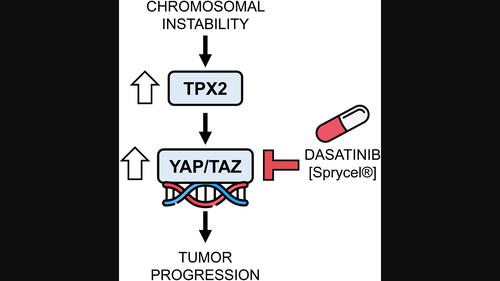当前位置:
X-MOL 学术
›
Mol. Oncol.
›
论文详情
Our official English website, www.x-mol.net, welcomes your feedback! (Note: you will need to create a separate account there.)
TPX2 overexpression promotes sensitivity to dasatinib in breast cancer by activating YAP transcriptional signaling
Molecular Oncology ( IF 6.6 ) Pub Date : 2024-02-15 , DOI: 10.1002/1878-0261.13602 Carlos Marugán 1, 2 , Natalia Sanz‐Gómez 1 , Beatriz Ortigosa 1, 3 , Ana Monfort‐Vengut 1 , Cristina Bertinetti 1 , Ana Teijo 4 , Marta González 1 , Alicia Alonso de la Vega 1 , María José Lallena 2 , Gema Moreno‐Bueno 3, 5, 6, 7 , Guillermo de Cárcer 1, 7
Molecular Oncology ( IF 6.6 ) Pub Date : 2024-02-15 , DOI: 10.1002/1878-0261.13602 Carlos Marugán 1, 2 , Natalia Sanz‐Gómez 1 , Beatriz Ortigosa 1, 3 , Ana Monfort‐Vengut 1 , Cristina Bertinetti 1 , Ana Teijo 4 , Marta González 1 , Alicia Alonso de la Vega 1 , María José Lallena 2 , Gema Moreno‐Bueno 3, 5, 6, 7 , Guillermo de Cárcer 1, 7
Affiliation

|
Chromosomal instability (CIN) is a hallmark of cancer aggressiveness, providing genetic plasticity and tumor heterogeneity that allows the tumor to evolve and adapt to stress conditions. CIN is considered a cancer therapeutic biomarker because healthy cells do not exhibit CIN. Despite recent efforts to identify therapeutic strategies related to CIN, the results obtained have been very limited. CIN is characterized by a genetic signature where a collection of genes, mostly mitotic regulators, are overexpressed in CIN-positive tumors, providing aggressiveness and poor prognosis. We attempted to identify new therapeutic strategies related to CIN genes by performing a drug screen, using cells that individually express CIN-associated genes in an inducible manner. We find that the overexpression of targeting protein for Xklp2 (TPX2) enhances sensitivity to the proto-oncogene c-Src (SRC) inhibitor dasatinib due to activation of the Yes-associated protein 1 (YAP) pathway. Furthermore, using breast cancer data from The Cancer Genome Atlas (TCGA) and a cohort of cancer-derived patient samples, we find that both TPX2 overexpression and YAP activation are present in a significant percentage of cancer tumor samples and are associated with poor prognosis; therefore, they are putative biomarkers for selection for dasatinib therapy.
中文翻译:

TPX2 过表达通过激活 YAP 转录信号促进乳腺癌对达沙替尼的敏感性
染色体不稳定性(CIN)是癌症侵袭性的标志,提供遗传可塑性和肿瘤异质性,使肿瘤能够进化并适应应激条件。CIN 被认为是癌症治疗生物标志物,因为健康细胞不表现出 CIN。尽管最近努力确定与 CIN 相关的治疗策略,但获得的结果非常有限。CIN 的特征是其遗传特征,其中一系列基因(主要是有丝分裂调节因子)在 CIN 阳性肿瘤中过度表达,从而导致侵袭性和不良预后。我们试图通过使用以诱导方式单独表达 CIN 相关基因的细胞进行药物筛选来确定与 CIN 基因相关的新治疗策略。我们发现,由于 Yes 相关蛋白 1 (YAP) 通路的激活,Xklp2 ( TPX2 ) 靶向蛋白的过度表达增强了对原癌基因 c-Src (SRC) 抑制剂达沙替尼 (dasatinib) 的敏感性。此外,利用来自癌症基因组图谱 (TCGA) 的乳腺癌数据和一组癌症患者样本,我们发现TPX2过度表达和 YAP 激活都存在于很大比例的癌症肿瘤样本中,并且与不良预后相关。因此,它们是选择达沙替尼治疗的推定生物标志物。
更新日期:2024-02-15
中文翻译:

TPX2 过表达通过激活 YAP 转录信号促进乳腺癌对达沙替尼的敏感性
染色体不稳定性(CIN)是癌症侵袭性的标志,提供遗传可塑性和肿瘤异质性,使肿瘤能够进化并适应应激条件。CIN 被认为是癌症治疗生物标志物,因为健康细胞不表现出 CIN。尽管最近努力确定与 CIN 相关的治疗策略,但获得的结果非常有限。CIN 的特征是其遗传特征,其中一系列基因(主要是有丝分裂调节因子)在 CIN 阳性肿瘤中过度表达,从而导致侵袭性和不良预后。我们试图通过使用以诱导方式单独表达 CIN 相关基因的细胞进行药物筛选来确定与 CIN 基因相关的新治疗策略。我们发现,由于 Yes 相关蛋白 1 (YAP) 通路的激活,Xklp2 ( TPX2 ) 靶向蛋白的过度表达增强了对原癌基因 c-Src (SRC) 抑制剂达沙替尼 (dasatinib) 的敏感性。此外,利用来自癌症基因组图谱 (TCGA) 的乳腺癌数据和一组癌症患者样本,我们发现TPX2过度表达和 YAP 激活都存在于很大比例的癌症肿瘤样本中,并且与不良预后相关。因此,它们是选择达沙替尼治疗的推定生物标志物。



























 京公网安备 11010802027423号
京公网安备 11010802027423号